Systematic Review of Tuberculosis in Bangladesh: A Comprehensive Study
VerifiedAdded on 2019/12/28
|67
|19714
|241
Report
AI Summary
This report presents a systematic review investigating the prevalence and determinants of tuberculosis (TB) in Bangladesh. The study examines the increasing incidence of TB, its associated stigma, and the underlying reasons for its prevalence. The review employs a systematic literature review methodology, analyzing various databases using specific search terms and Boolean operators. Key findings highlight the prevalence of TB in poorer sections, urban slums, and prisons, with determinants including social contact patterns, lack of awareness, inequitable health benefits, health system delays, and high prevalence in prisons. The report emphasizes the significant impact of TB stigma, leading to delayed diagnosis and treatment, thus exacerbating the disease's prevalence. The conclusion suggests that various determinants are responsible for the high prevalence of TB in Bangladesh, underscoring the need for increased awareness, improved health system efficiency, and equitable access to treatment services. The review also includes an introduction, literature review, methods, results, discussion, and conclusion, providing a comprehensive analysis of the issue and its implications for public health policy.
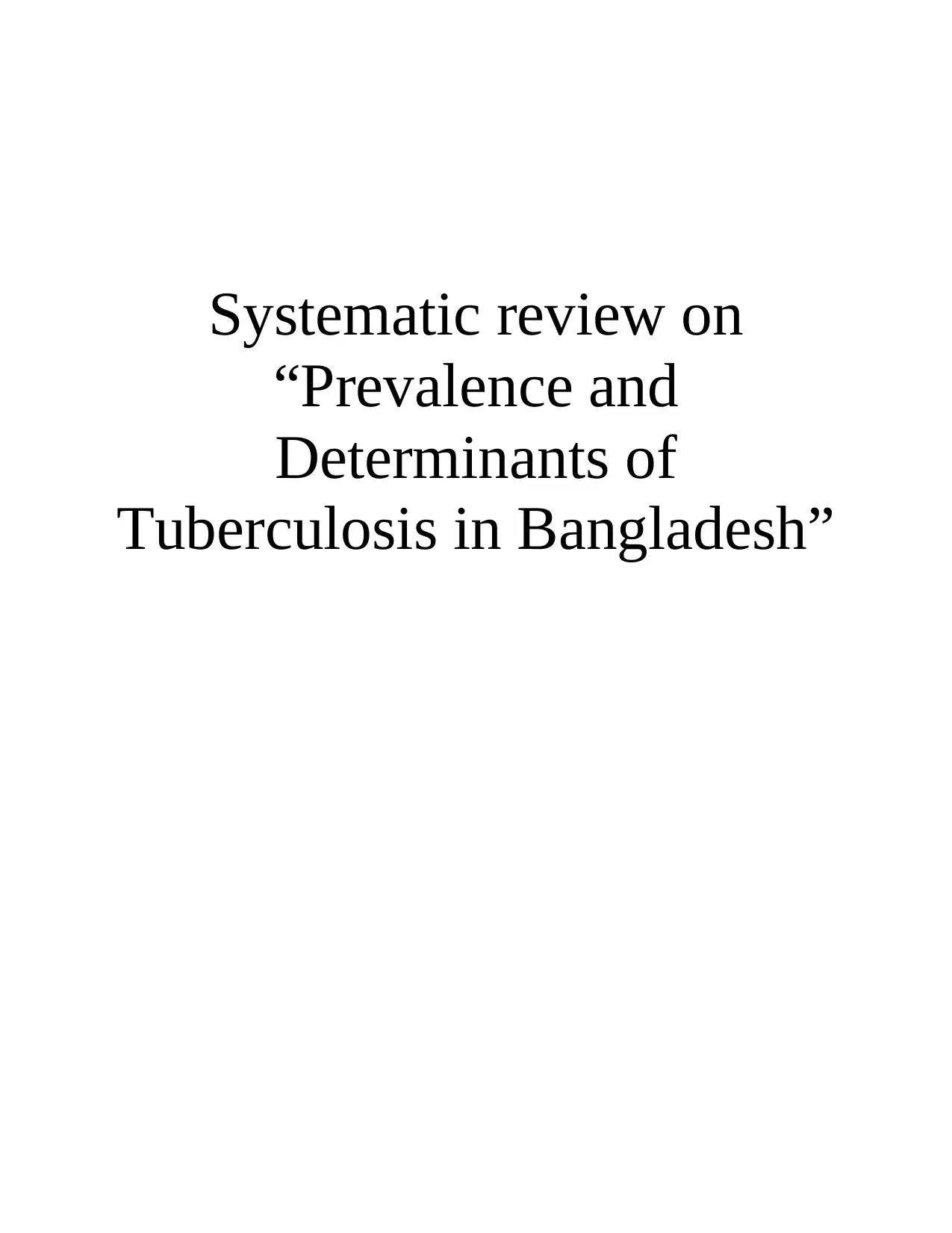
Systematic review on
“Prevalence and
Determinants of
Tuberculosis in Bangladesh”
“Prevalence and
Determinants of
Tuberculosis in Bangladesh”
Paraphrase This Document
Need a fresh take? Get an instant paraphrase of this document with our AI Paraphraser
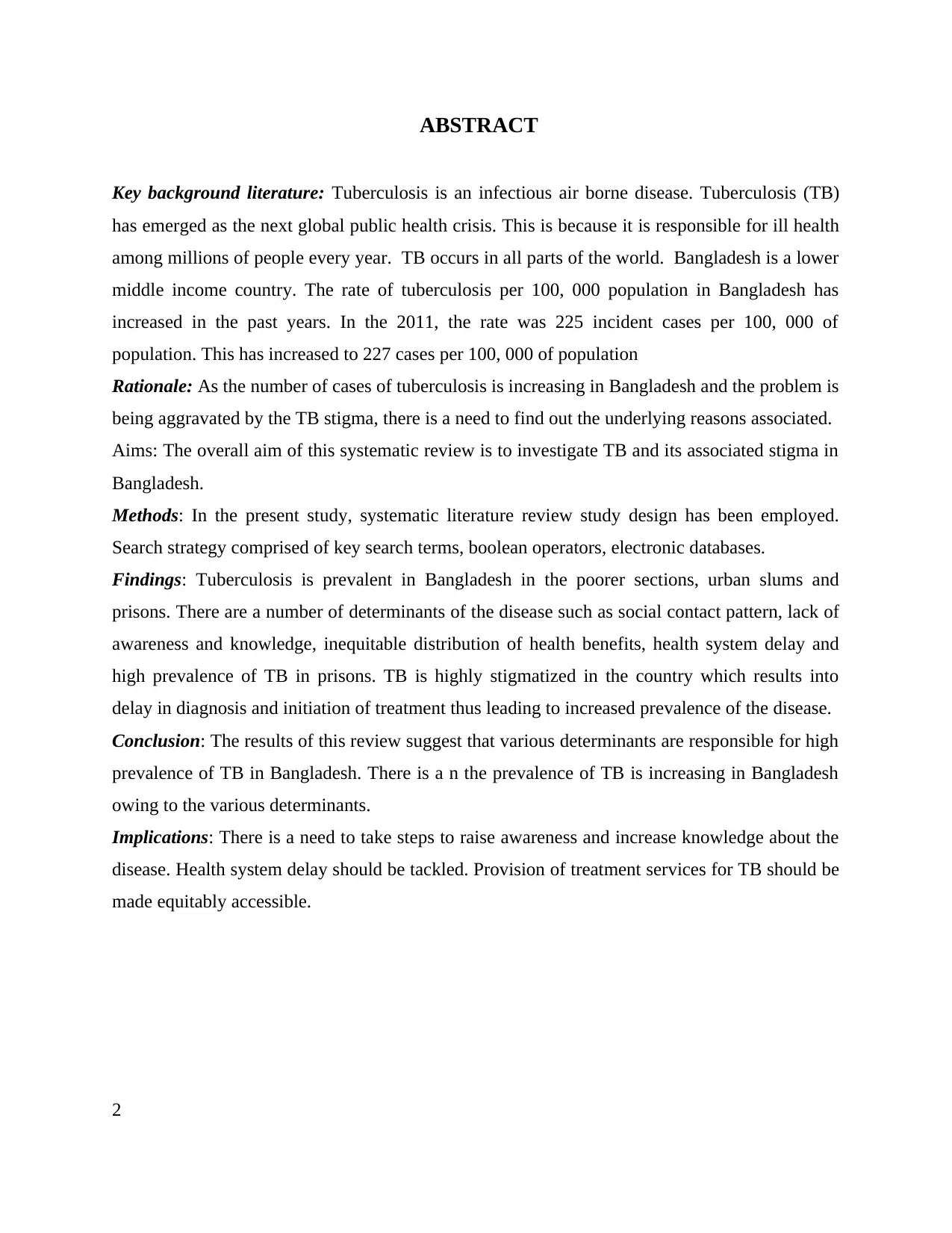
ABSTRACT
Key background literature: Tuberculosis is an infectious air borne disease. Tuberculosis (TB)
has emerged as the next global public health crisis. This is because it is responsible for ill health
among millions of people every year. TB occurs in all parts of the world. Bangladesh is a lower
middle income country. The rate of tuberculosis per 100, 000 population in Bangladesh has
increased in the past years. In the 2011, the rate was 225 incident cases per 100, 000 of
population. This has increased to 227 cases per 100, 000 of population
Rationale: As the number of cases of tuberculosis is increasing in Bangladesh and the problem is
being aggravated by the TB stigma, there is a need to find out the underlying reasons associated.
Aims: The overall aim of this systematic review is to investigate TB and its associated stigma in
Bangladesh.
Methods: In the present study, systematic literature review study design has been employed.
Search strategy comprised of key search terms, boolean operators, electronic databases.
Findings: Tuberculosis is prevalent in Bangladesh in the poorer sections, urban slums and
prisons. There are a number of determinants of the disease such as social contact pattern, lack of
awareness and knowledge, inequitable distribution of health benefits, health system delay and
high prevalence of TB in prisons. TB is highly stigmatized in the country which results into
delay in diagnosis and initiation of treatment thus leading to increased prevalence of the disease.
Conclusion: The results of this review suggest that various determinants are responsible for high
prevalence of TB in Bangladesh. There is a n the prevalence of TB is increasing in Bangladesh
owing to the various determinants.
Implications: There is a need to take steps to raise awareness and increase knowledge about the
disease. Health system delay should be tackled. Provision of treatment services for TB should be
made equitably accessible.
2
Key background literature: Tuberculosis is an infectious air borne disease. Tuberculosis (TB)
has emerged as the next global public health crisis. This is because it is responsible for ill health
among millions of people every year. TB occurs in all parts of the world. Bangladesh is a lower
middle income country. The rate of tuberculosis per 100, 000 population in Bangladesh has
increased in the past years. In the 2011, the rate was 225 incident cases per 100, 000 of
population. This has increased to 227 cases per 100, 000 of population
Rationale: As the number of cases of tuberculosis is increasing in Bangladesh and the problem is
being aggravated by the TB stigma, there is a need to find out the underlying reasons associated.
Aims: The overall aim of this systematic review is to investigate TB and its associated stigma in
Bangladesh.
Methods: In the present study, systematic literature review study design has been employed.
Search strategy comprised of key search terms, boolean operators, electronic databases.
Findings: Tuberculosis is prevalent in Bangladesh in the poorer sections, urban slums and
prisons. There are a number of determinants of the disease such as social contact pattern, lack of
awareness and knowledge, inequitable distribution of health benefits, health system delay and
high prevalence of TB in prisons. TB is highly stigmatized in the country which results into
delay in diagnosis and initiation of treatment thus leading to increased prevalence of the disease.
Conclusion: The results of this review suggest that various determinants are responsible for high
prevalence of TB in Bangladesh. There is a n the prevalence of TB is increasing in Bangladesh
owing to the various determinants.
Implications: There is a need to take steps to raise awareness and increase knowledge about the
disease. Health system delay should be tackled. Provision of treatment services for TB should be
made equitably accessible.
2
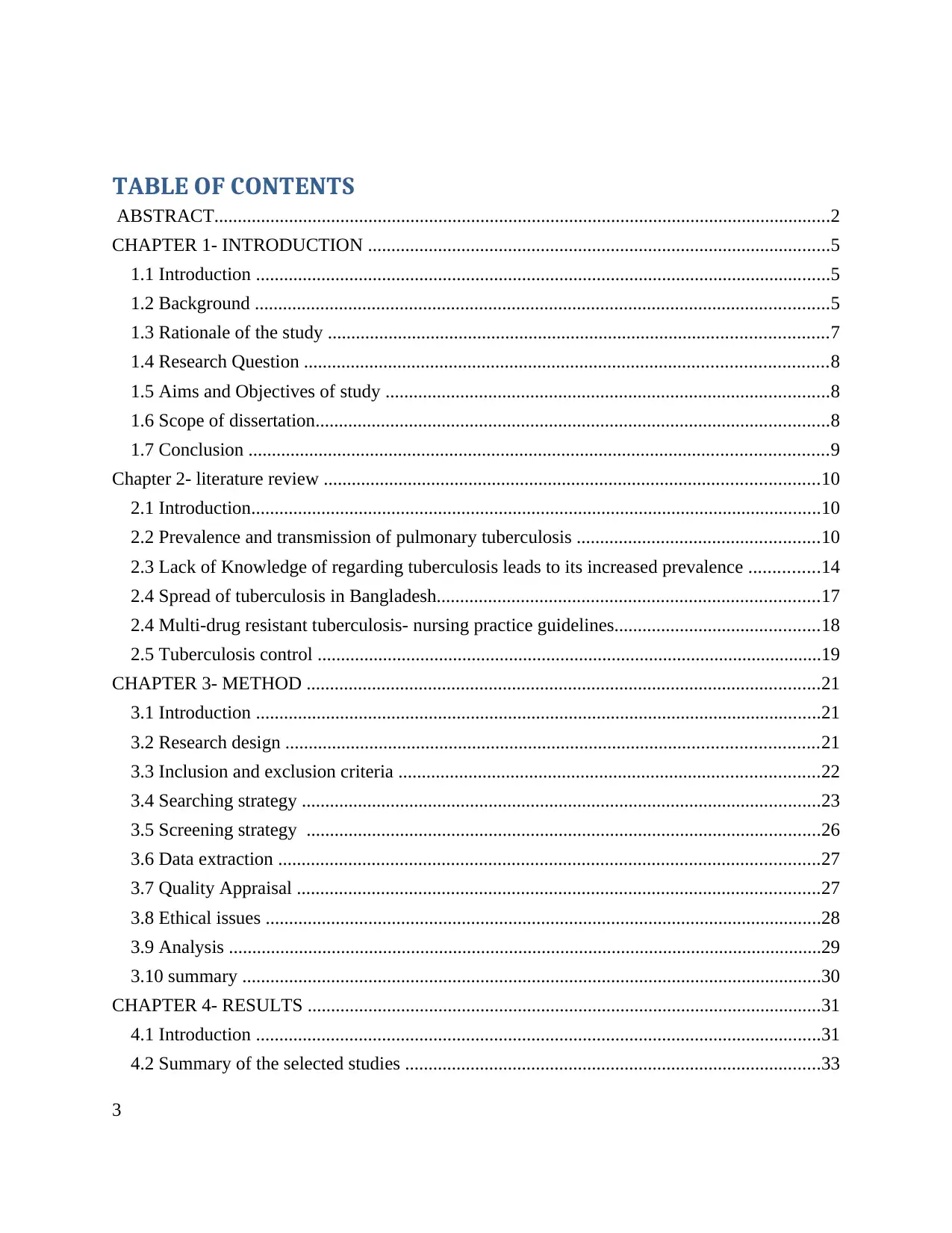
TABLE OF CONTENTS
ABSTRACT....................................................................................................................................2
CHAPTER 1- INTRODUCTION ...................................................................................................5
1.1 Introduction ...........................................................................................................................5
1.2 Background ...........................................................................................................................5
1.3 Rationale of the study ...........................................................................................................7
1.4 Research Question ................................................................................................................8
1.5 Aims and Objectives of study ...............................................................................................8
1.6 Scope of dissertation..............................................................................................................8
1.7 Conclusion ............................................................................................................................9
Chapter 2- literature review ..........................................................................................................10
2.1 Introduction..........................................................................................................................10
2.2 Prevalence and transmission of pulmonary tuberculosis ....................................................10
2.3 Lack of Knowledge of regarding tuberculosis leads to its increased prevalence ...............14
2.4 Spread of tuberculosis in Bangladesh..................................................................................17
2.4 Multi-drug resistant tuberculosis- nursing practice guidelines............................................18
2.5 Tuberculosis control ............................................................................................................19
CHAPTER 3- METHOD ..............................................................................................................21
3.1 Introduction .........................................................................................................................21
3.2 Research design ..................................................................................................................21
3.3 Inclusion and exclusion criteria ..........................................................................................22
3.4 Searching strategy ...............................................................................................................23
3.5 Screening strategy ..............................................................................................................26
3.6 Data extraction ....................................................................................................................27
3.7 Quality Appraisal ................................................................................................................27
3.8 Ethical issues .......................................................................................................................28
3.9 Analysis ...............................................................................................................................29
3.10 summary ............................................................................................................................30
CHAPTER 4- RESULTS ..............................................................................................................31
4.1 Introduction .........................................................................................................................31
4.2 Summary of the selected studies .........................................................................................33
3
ABSTRACT....................................................................................................................................2
CHAPTER 1- INTRODUCTION ...................................................................................................5
1.1 Introduction ...........................................................................................................................5
1.2 Background ...........................................................................................................................5
1.3 Rationale of the study ...........................................................................................................7
1.4 Research Question ................................................................................................................8
1.5 Aims and Objectives of study ...............................................................................................8
1.6 Scope of dissertation..............................................................................................................8
1.7 Conclusion ............................................................................................................................9
Chapter 2- literature review ..........................................................................................................10
2.1 Introduction..........................................................................................................................10
2.2 Prevalence and transmission of pulmonary tuberculosis ....................................................10
2.3 Lack of Knowledge of regarding tuberculosis leads to its increased prevalence ...............14
2.4 Spread of tuberculosis in Bangladesh..................................................................................17
2.4 Multi-drug resistant tuberculosis- nursing practice guidelines............................................18
2.5 Tuberculosis control ............................................................................................................19
CHAPTER 3- METHOD ..............................................................................................................21
3.1 Introduction .........................................................................................................................21
3.2 Research design ..................................................................................................................21
3.3 Inclusion and exclusion criteria ..........................................................................................22
3.4 Searching strategy ...............................................................................................................23
3.5 Screening strategy ..............................................................................................................26
3.6 Data extraction ....................................................................................................................27
3.7 Quality Appraisal ................................................................................................................27
3.8 Ethical issues .......................................................................................................................28
3.9 Analysis ...............................................................................................................................29
3.10 summary ............................................................................................................................30
CHAPTER 4- RESULTS ..............................................................................................................31
4.1 Introduction .........................................................................................................................31
4.2 Summary of the selected studies .........................................................................................33
3
⊘ This is a preview!⊘
Do you want full access?
Subscribe today to unlock all pages.

Trusted by 1+ million students worldwide
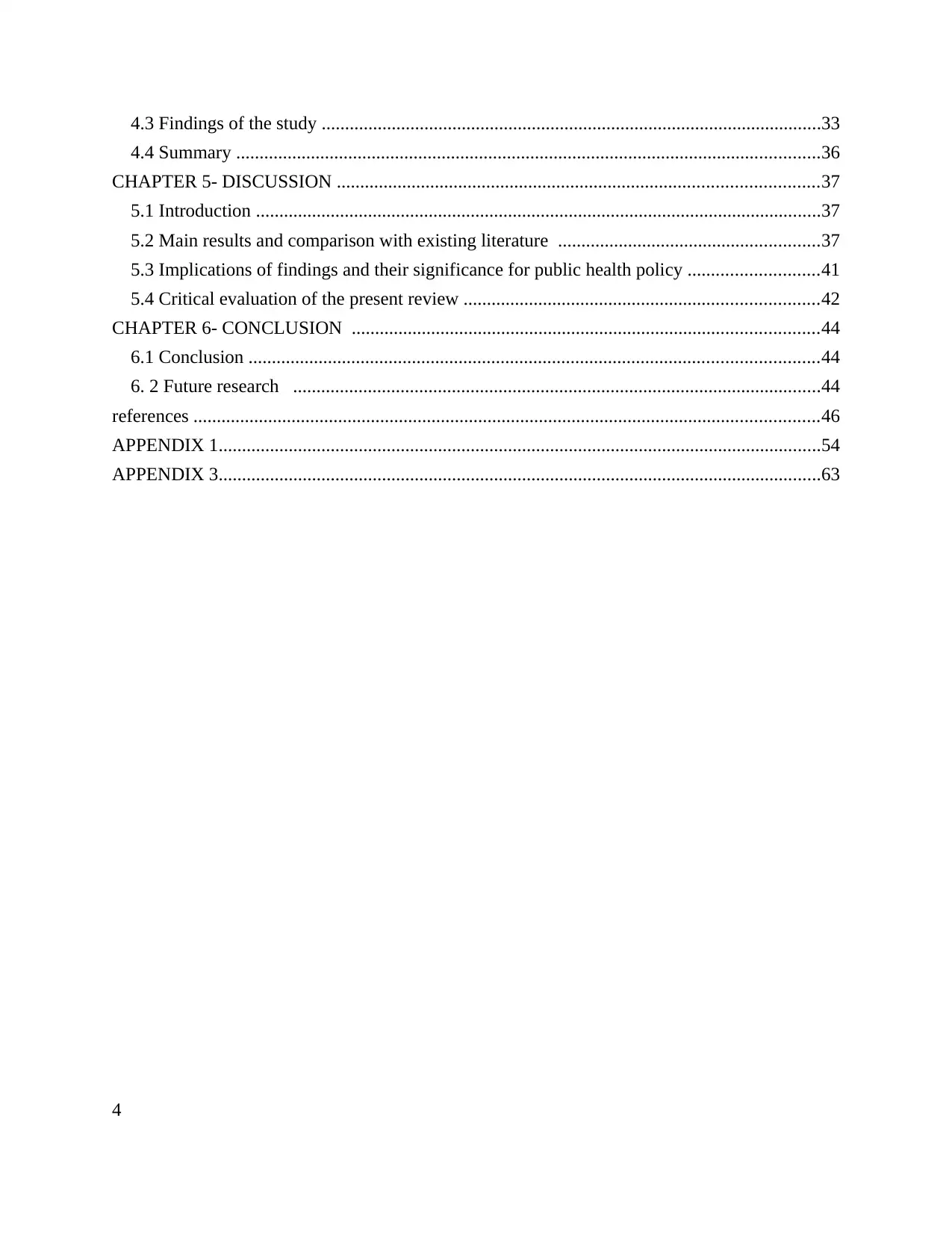
4.3 Findings of the study ...........................................................................................................33
4.4 Summary .............................................................................................................................36
CHAPTER 5- DISCUSSION .......................................................................................................37
5.1 Introduction .........................................................................................................................37
5.2 Main results and comparison with existing literature ........................................................37
5.3 Implications of findings and their significance for public health policy ............................41
5.4 Critical evaluation of the present review ............................................................................42
CHAPTER 6- CONCLUSION ....................................................................................................44
6.1 Conclusion ..........................................................................................................................44
6. 2 Future research .................................................................................................................44
references ......................................................................................................................................46
APPENDIX 1.................................................................................................................................54
APPENDIX 3.................................................................................................................................63
4
4.4 Summary .............................................................................................................................36
CHAPTER 5- DISCUSSION .......................................................................................................37
5.1 Introduction .........................................................................................................................37
5.2 Main results and comparison with existing literature ........................................................37
5.3 Implications of findings and their significance for public health policy ............................41
5.4 Critical evaluation of the present review ............................................................................42
CHAPTER 6- CONCLUSION ....................................................................................................44
6.1 Conclusion ..........................................................................................................................44
6. 2 Future research .................................................................................................................44
references ......................................................................................................................................46
APPENDIX 1.................................................................................................................................54
APPENDIX 3.................................................................................................................................63
4
Paraphrase This Document
Need a fresh take? Get an instant paraphrase of this document with our AI Paraphraser
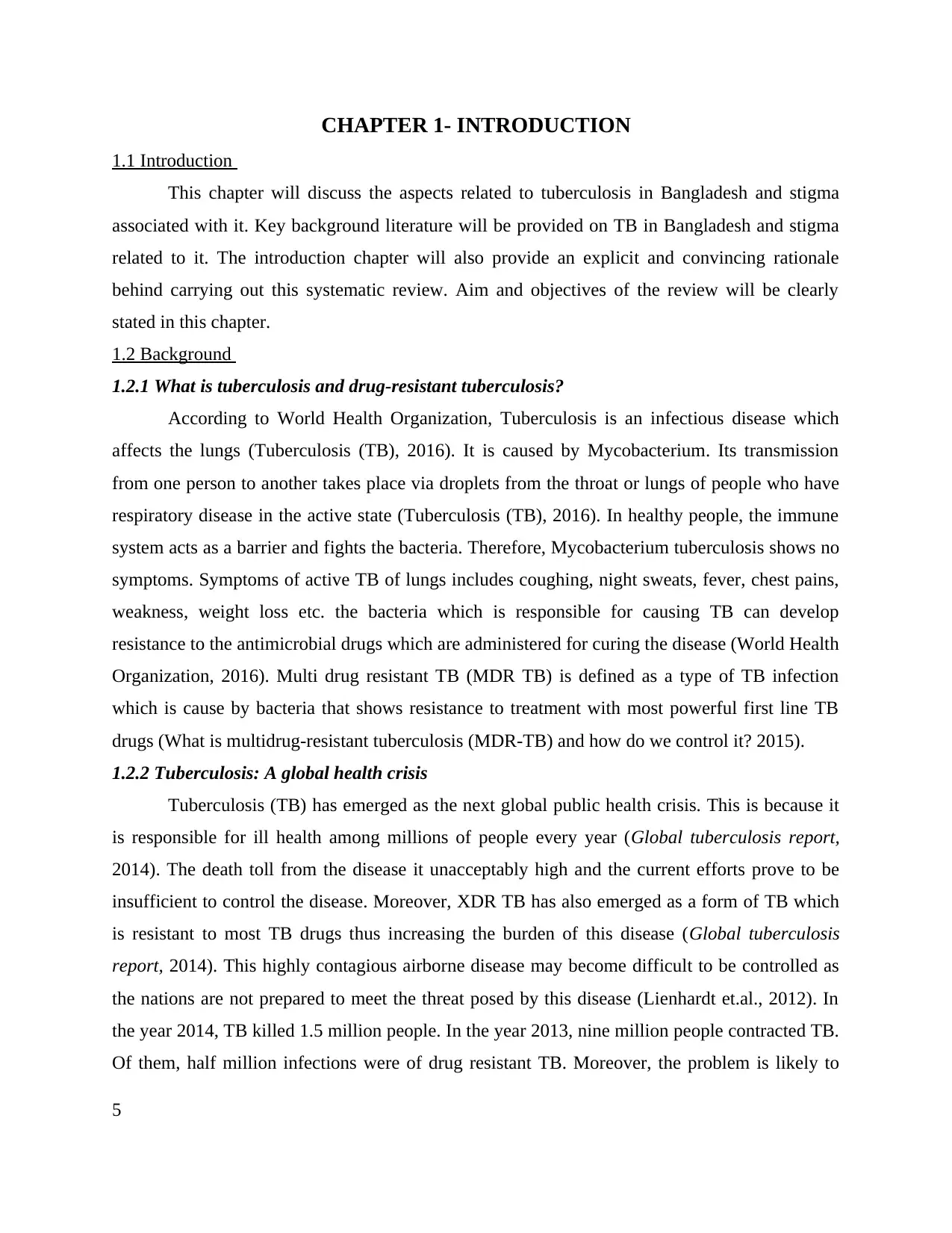
CHAPTER 1- INTRODUCTION
1.1 Introduction
This chapter will discuss the aspects related to tuberculosis in Bangladesh and stigma
associated with it. Key background literature will be provided on TB in Bangladesh and stigma
related to it. The introduction chapter will also provide an explicit and convincing rationale
behind carrying out this systematic review. Aim and objectives of the review will be clearly
stated in this chapter.
1.2 Background
1.2.1 What is tuberculosis and drug-resistant tuberculosis?
According to World Health Organization, Tuberculosis is an infectious disease which
affects the lungs (Tuberculosis (TB), 2016). It is caused by Mycobacterium. Its transmission
from one person to another takes place via droplets from the throat or lungs of people who have
respiratory disease in the active state (Tuberculosis (TB), 2016). In healthy people, the immune
system acts as a barrier and fights the bacteria. Therefore, Mycobacterium tuberculosis shows no
symptoms. Symptoms of active TB of lungs includes coughing, night sweats, fever, chest pains,
weakness, weight loss etc. the bacteria which is responsible for causing TB can develop
resistance to the antimicrobial drugs which are administered for curing the disease (World Health
Organization, 2016). Multi drug resistant TB (MDR TB) is defined as a type of TB infection
which is cause by bacteria that shows resistance to treatment with most powerful first line TB
drugs (What is multidrug-resistant tuberculosis (MDR-TB) and how do we control it? 2015).
1.2.2 Tuberculosis: A global health crisis
Tuberculosis (TB) has emerged as the next global public health crisis. This is because it
is responsible for ill health among millions of people every year (Global tuberculosis report,
2014). The death toll from the disease it unacceptably high and the current efforts prove to be
insufficient to control the disease. Moreover, XDR TB has also emerged as a form of TB which
is resistant to most TB drugs thus increasing the burden of this disease (Global tuberculosis
report, 2014). This highly contagious airborne disease may become difficult to be controlled as
the nations are not prepared to meet the threat posed by this disease (Lienhardt et.al., 2012). In
the year 2014, TB killed 1.5 million people. In the year 2013, nine million people contracted TB.
Of them, half million infections were of drug resistant TB. Moreover, the problem is likely to
5
1.1 Introduction
This chapter will discuss the aspects related to tuberculosis in Bangladesh and stigma
associated with it. Key background literature will be provided on TB in Bangladesh and stigma
related to it. The introduction chapter will also provide an explicit and convincing rationale
behind carrying out this systematic review. Aim and objectives of the review will be clearly
stated in this chapter.
1.2 Background
1.2.1 What is tuberculosis and drug-resistant tuberculosis?
According to World Health Organization, Tuberculosis is an infectious disease which
affects the lungs (Tuberculosis (TB), 2016). It is caused by Mycobacterium. Its transmission
from one person to another takes place via droplets from the throat or lungs of people who have
respiratory disease in the active state (Tuberculosis (TB), 2016). In healthy people, the immune
system acts as a barrier and fights the bacteria. Therefore, Mycobacterium tuberculosis shows no
symptoms. Symptoms of active TB of lungs includes coughing, night sweats, fever, chest pains,
weakness, weight loss etc. the bacteria which is responsible for causing TB can develop
resistance to the antimicrobial drugs which are administered for curing the disease (World Health
Organization, 2016). Multi drug resistant TB (MDR TB) is defined as a type of TB infection
which is cause by bacteria that shows resistance to treatment with most powerful first line TB
drugs (What is multidrug-resistant tuberculosis (MDR-TB) and how do we control it? 2015).
1.2.2 Tuberculosis: A global health crisis
Tuberculosis (TB) has emerged as the next global public health crisis. This is because it
is responsible for ill health among millions of people every year (Global tuberculosis report,
2014). The death toll from the disease it unacceptably high and the current efforts prove to be
insufficient to control the disease. Moreover, XDR TB has also emerged as a form of TB which
is resistant to most TB drugs thus increasing the burden of this disease (Global tuberculosis
report, 2014). This highly contagious airborne disease may become difficult to be controlled as
the nations are not prepared to meet the threat posed by this disease (Lienhardt et.al., 2012). In
the year 2014, TB killed 1.5 million people. In the year 2013, nine million people contracted TB.
Of them, half million infections were of drug resistant TB. Moreover, the problem is likely to
5
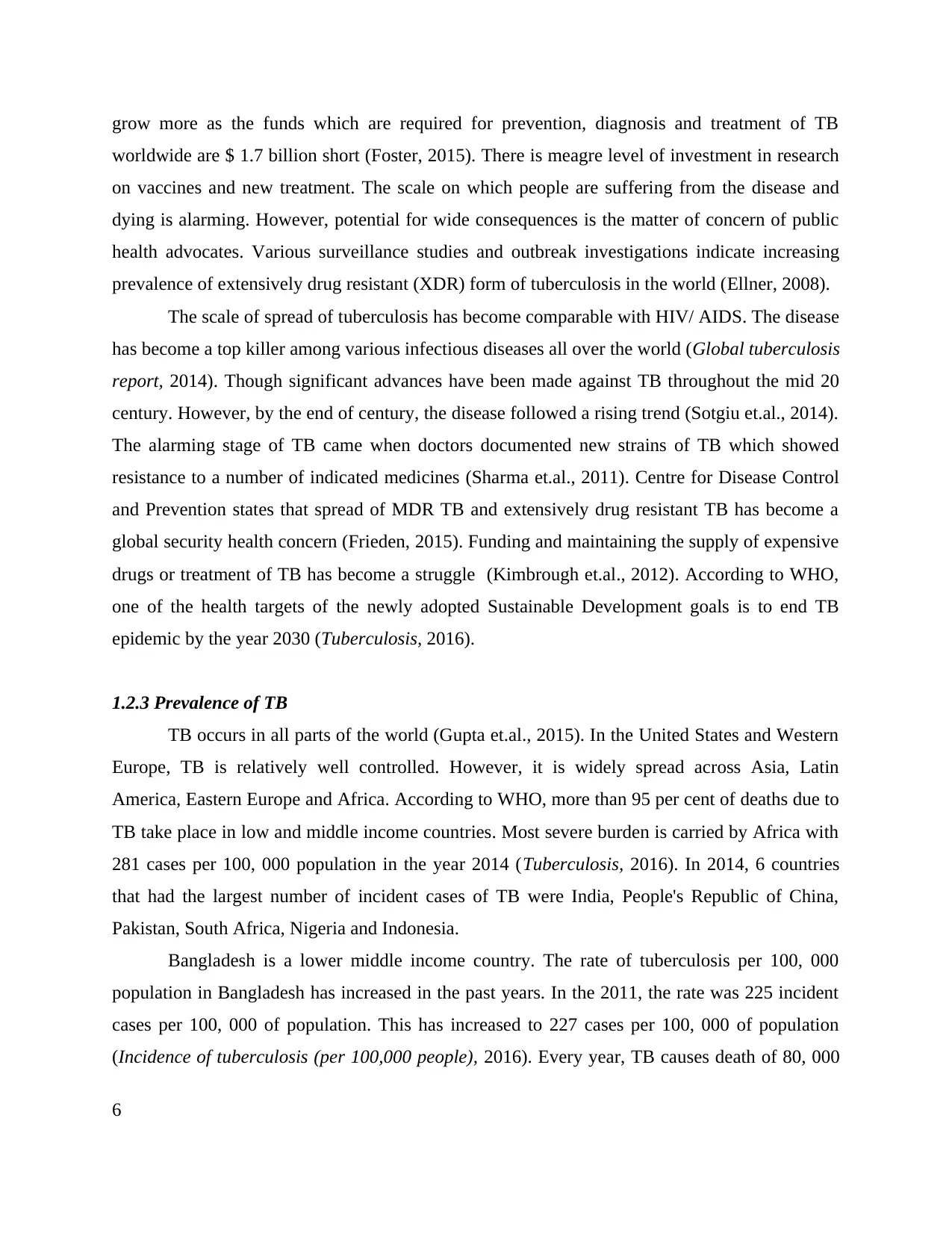
grow more as the funds which are required for prevention, diagnosis and treatment of TB
worldwide are $ 1.7 billion short (Foster, 2015). There is meagre level of investment in research
on vaccines and new treatment. The scale on which people are suffering from the disease and
dying is alarming. However, potential for wide consequences is the matter of concern of public
health advocates. Various surveillance studies and outbreak investigations indicate increasing
prevalence of extensively drug resistant (XDR) form of tuberculosis in the world (Ellner, 2008).
The scale of spread of tuberculosis has become comparable with HIV/ AIDS. The disease
has become a top killer among various infectious diseases all over the world (Global tuberculosis
report, 2014). Though significant advances have been made against TB throughout the mid 20
century. However, by the end of century, the disease followed a rising trend (Sotgiu et.al., 2014).
The alarming stage of TB came when doctors documented new strains of TB which showed
resistance to a number of indicated medicines (Sharma et.al., 2011). Centre for Disease Control
and Prevention states that spread of MDR TB and extensively drug resistant TB has become a
global security health concern (Frieden, 2015). Funding and maintaining the supply of expensive
drugs or treatment of TB has become a struggle (Kimbrough et.al., 2012). According to WHO,
one of the health targets of the newly adopted Sustainable Development goals is to end TB
epidemic by the year 2030 (Tuberculosis, 2016).
1.2.3 Prevalence of TB
TB occurs in all parts of the world (Gupta et.al., 2015). In the United States and Western
Europe, TB is relatively well controlled. However, it is widely spread across Asia, Latin
America, Eastern Europe and Africa. According to WHO, more than 95 per cent of deaths due to
TB take place in low and middle income countries. Most severe burden is carried by Africa with
281 cases per 100, 000 population in the year 2014 (Tuberculosis, 2016). In 2014, 6 countries
that had the largest number of incident cases of TB were India, People's Republic of China,
Pakistan, South Africa, Nigeria and Indonesia.
Bangladesh is a lower middle income country. The rate of tuberculosis per 100, 000
population in Bangladesh has increased in the past years. In the 2011, the rate was 225 incident
cases per 100, 000 of population. This has increased to 227 cases per 100, 000 of population
(Incidence of tuberculosis (per 100,000 people), 2016). Every year, TB causes death of 80, 000
6
worldwide are $ 1.7 billion short (Foster, 2015). There is meagre level of investment in research
on vaccines and new treatment. The scale on which people are suffering from the disease and
dying is alarming. However, potential for wide consequences is the matter of concern of public
health advocates. Various surveillance studies and outbreak investigations indicate increasing
prevalence of extensively drug resistant (XDR) form of tuberculosis in the world (Ellner, 2008).
The scale of spread of tuberculosis has become comparable with HIV/ AIDS. The disease
has become a top killer among various infectious diseases all over the world (Global tuberculosis
report, 2014). Though significant advances have been made against TB throughout the mid 20
century. However, by the end of century, the disease followed a rising trend (Sotgiu et.al., 2014).
The alarming stage of TB came when doctors documented new strains of TB which showed
resistance to a number of indicated medicines (Sharma et.al., 2011). Centre for Disease Control
and Prevention states that spread of MDR TB and extensively drug resistant TB has become a
global security health concern (Frieden, 2015). Funding and maintaining the supply of expensive
drugs or treatment of TB has become a struggle (Kimbrough et.al., 2012). According to WHO,
one of the health targets of the newly adopted Sustainable Development goals is to end TB
epidemic by the year 2030 (Tuberculosis, 2016).
1.2.3 Prevalence of TB
TB occurs in all parts of the world (Gupta et.al., 2015). In the United States and Western
Europe, TB is relatively well controlled. However, it is widely spread across Asia, Latin
America, Eastern Europe and Africa. According to WHO, more than 95 per cent of deaths due to
TB take place in low and middle income countries. Most severe burden is carried by Africa with
281 cases per 100, 000 population in the year 2014 (Tuberculosis, 2016). In 2014, 6 countries
that had the largest number of incident cases of TB were India, People's Republic of China,
Pakistan, South Africa, Nigeria and Indonesia.
Bangladesh is a lower middle income country. The rate of tuberculosis per 100, 000
population in Bangladesh has increased in the past years. In the 2011, the rate was 225 incident
cases per 100, 000 of population. This has increased to 227 cases per 100, 000 of population
(Incidence of tuberculosis (per 100,000 people), 2016). Every year, TB causes death of 80, 000
6
⊘ This is a preview!⊘
Do you want full access?
Subscribe today to unlock all pages.

Trusted by 1+ million students worldwide
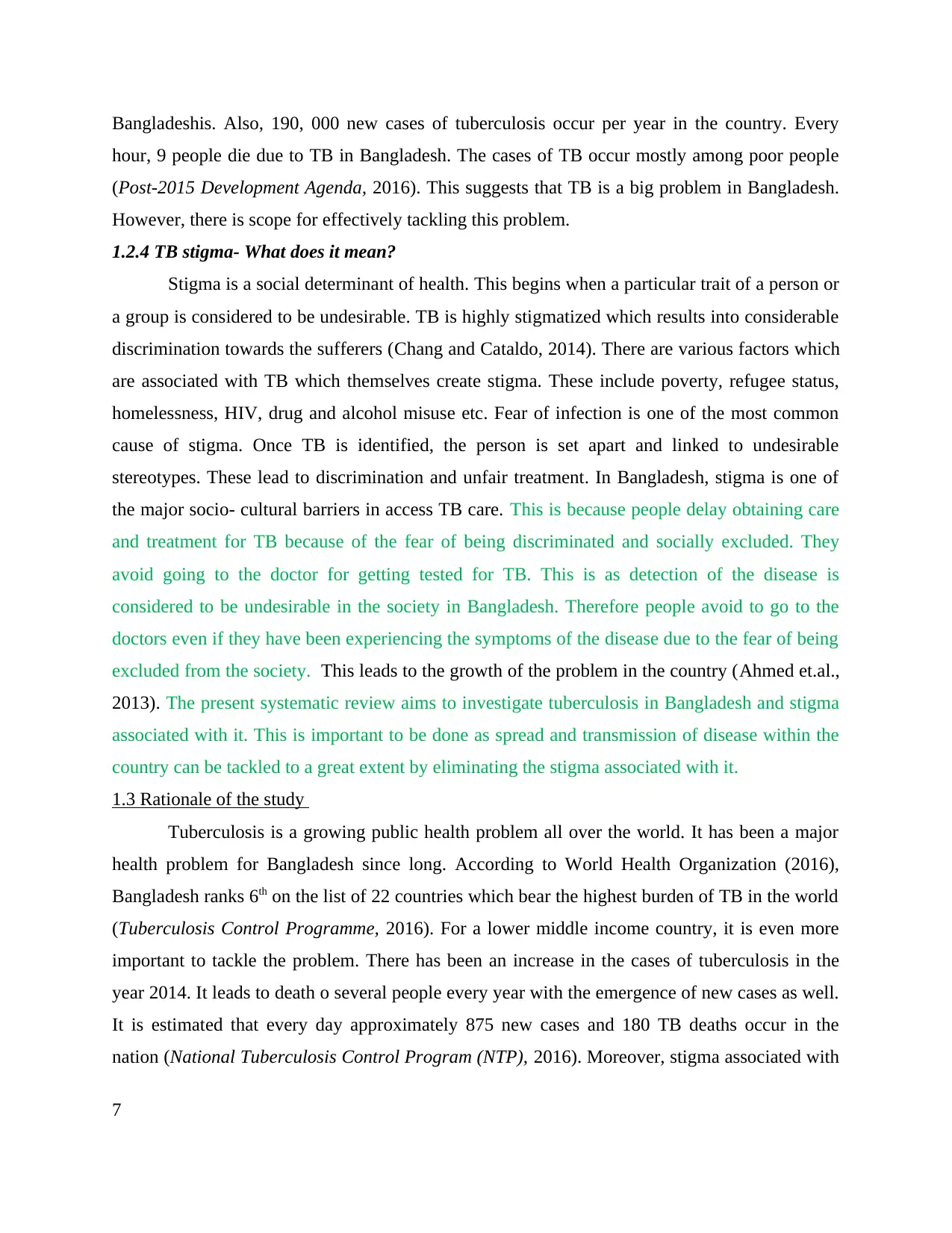
Bangladeshis. Also, 190, 000 new cases of tuberculosis occur per year in the country. Every
hour, 9 people die due to TB in Bangladesh. The cases of TB occur mostly among poor people
(Post-2015 Development Agenda, 2016). This suggests that TB is a big problem in Bangladesh.
However, there is scope for effectively tackling this problem.
1.2.4 TB stigma- What does it mean?
Stigma is a social determinant of health. This begins when a particular trait of a person or
a group is considered to be undesirable. TB is highly stigmatized which results into considerable
discrimination towards the sufferers (Chang and Cataldo, 2014). There are various factors which
are associated with TB which themselves create stigma. These include poverty, refugee status,
homelessness, HIV, drug and alcohol misuse etc. Fear of infection is one of the most common
cause of stigma. Once TB is identified, the person is set apart and linked to undesirable
stereotypes. These lead to discrimination and unfair treatment. In Bangladesh, stigma is one of
the major socio- cultural barriers in access TB care. This is because people delay obtaining care
and treatment for TB because of the fear of being discriminated and socially excluded. They
avoid going to the doctor for getting tested for TB. This is as detection of the disease is
considered to be undesirable in the society in Bangladesh. Therefore people avoid to go to the
doctors even if they have been experiencing the symptoms of the disease due to the fear of being
excluded from the society. This leads to the growth of the problem in the country (Ahmed et.al.,
2013). The present systematic review aims to investigate tuberculosis in Bangladesh and stigma
associated with it. This is important to be done as spread and transmission of disease within the
country can be tackled to a great extent by eliminating the stigma associated with it.
1.3 Rationale of the study
Tuberculosis is a growing public health problem all over the world. It has been a major
health problem for Bangladesh since long. According to World Health Organization (2016),
Bangladesh ranks 6th on the list of 22 countries which bear the highest burden of TB in the world
(Tuberculosis Control Programme, 2016). For a lower middle income country, it is even more
important to tackle the problem. There has been an increase in the cases of tuberculosis in the
year 2014. It leads to death o several people every year with the emergence of new cases as well.
It is estimated that every day approximately 875 new cases and 180 TB deaths occur in the
nation (National Tuberculosis Control Program (NTP), 2016). Moreover, stigma associated with
7
hour, 9 people die due to TB in Bangladesh. The cases of TB occur mostly among poor people
(Post-2015 Development Agenda, 2016). This suggests that TB is a big problem in Bangladesh.
However, there is scope for effectively tackling this problem.
1.2.4 TB stigma- What does it mean?
Stigma is a social determinant of health. This begins when a particular trait of a person or
a group is considered to be undesirable. TB is highly stigmatized which results into considerable
discrimination towards the sufferers (Chang and Cataldo, 2014). There are various factors which
are associated with TB which themselves create stigma. These include poverty, refugee status,
homelessness, HIV, drug and alcohol misuse etc. Fear of infection is one of the most common
cause of stigma. Once TB is identified, the person is set apart and linked to undesirable
stereotypes. These lead to discrimination and unfair treatment. In Bangladesh, stigma is one of
the major socio- cultural barriers in access TB care. This is because people delay obtaining care
and treatment for TB because of the fear of being discriminated and socially excluded. They
avoid going to the doctor for getting tested for TB. This is as detection of the disease is
considered to be undesirable in the society in Bangladesh. Therefore people avoid to go to the
doctors even if they have been experiencing the symptoms of the disease due to the fear of being
excluded from the society. This leads to the growth of the problem in the country (Ahmed et.al.,
2013). The present systematic review aims to investigate tuberculosis in Bangladesh and stigma
associated with it. This is important to be done as spread and transmission of disease within the
country can be tackled to a great extent by eliminating the stigma associated with it.
1.3 Rationale of the study
Tuberculosis is a growing public health problem all over the world. It has been a major
health problem for Bangladesh since long. According to World Health Organization (2016),
Bangladesh ranks 6th on the list of 22 countries which bear the highest burden of TB in the world
(Tuberculosis Control Programme, 2016). For a lower middle income country, it is even more
important to tackle the problem. There has been an increase in the cases of tuberculosis in the
year 2014. It leads to death o several people every year with the emergence of new cases as well.
It is estimated that every day approximately 875 new cases and 180 TB deaths occur in the
nation (National Tuberculosis Control Program (NTP), 2016). Moreover, stigma associated with
7
Paraphrase This Document
Need a fresh take? Get an instant paraphrase of this document with our AI Paraphraser
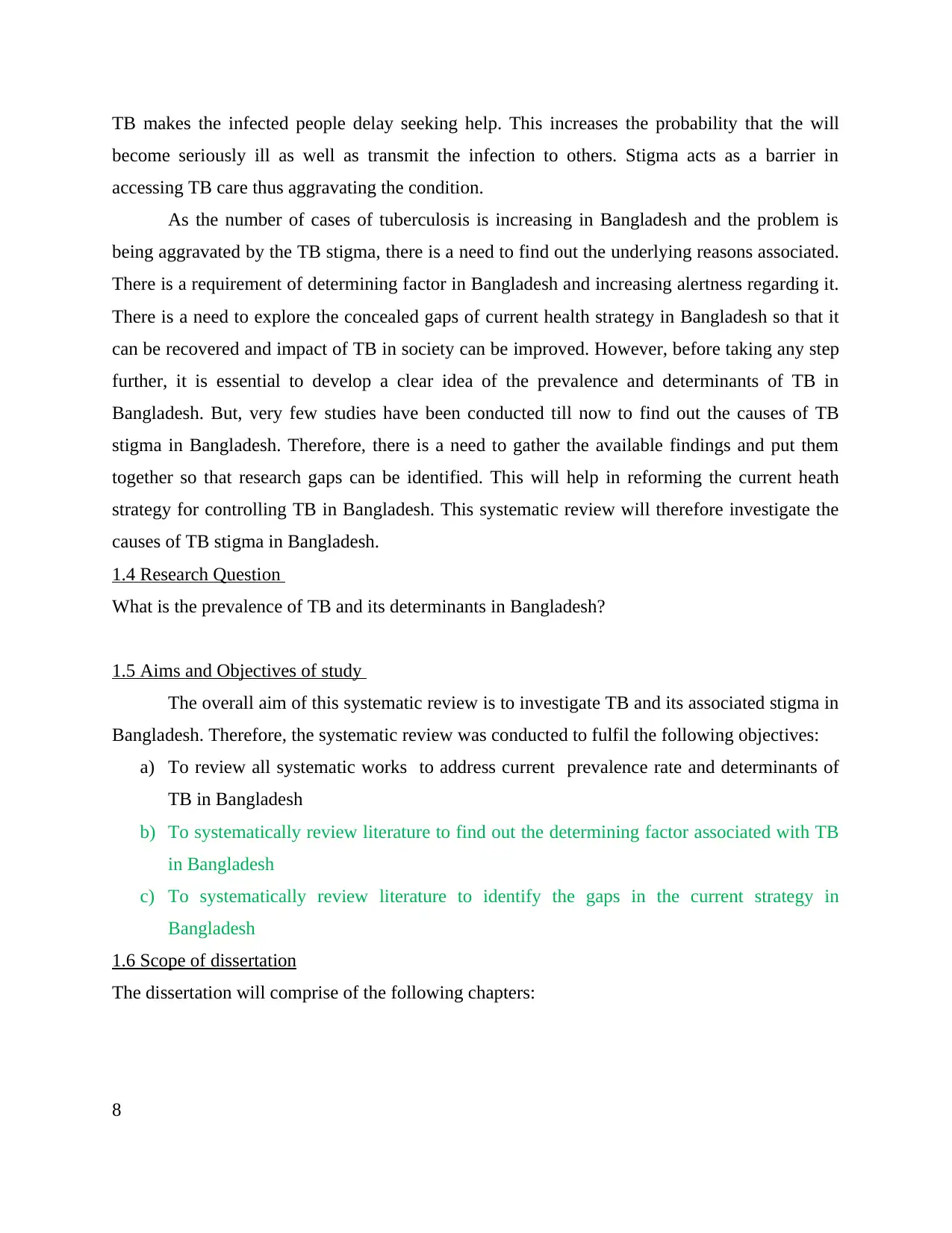
TB makes the infected people delay seeking help. This increases the probability that the will
become seriously ill as well as transmit the infection to others. Stigma acts as a barrier in
accessing TB care thus aggravating the condition.
As the number of cases of tuberculosis is increasing in Bangladesh and the problem is
being aggravated by the TB stigma, there is a need to find out the underlying reasons associated.
There is a requirement of determining factor in Bangladesh and increasing alertness regarding it.
There is a need to explore the concealed gaps of current health strategy in Bangladesh so that it
can be recovered and impact of TB in society can be improved. However, before taking any step
further, it is essential to develop a clear idea of the prevalence and determinants of TB in
Bangladesh. But, very few studies have been conducted till now to find out the causes of TB
stigma in Bangladesh. Therefore, there is a need to gather the available findings and put them
together so that research gaps can be identified. This will help in reforming the current heath
strategy for controlling TB in Bangladesh. This systematic review will therefore investigate the
causes of TB stigma in Bangladesh.
1.4 Research Question
What is the prevalence of TB and its determinants in Bangladesh?
1.5 Aims and Objectives of study
The overall aim of this systematic review is to investigate TB and its associated stigma in
Bangladesh. Therefore, the systematic review was conducted to fulfil the following objectives:
a) To review all systematic works to address current prevalence rate and determinants of
TB in Bangladesh
b) To systematically review literature to find out the determining factor associated with TB
in Bangladesh
c) To systematically review literature to identify the gaps in the current strategy in
Bangladesh
1.6 Scope of dissertation
The dissertation will comprise of the following chapters:
8
become seriously ill as well as transmit the infection to others. Stigma acts as a barrier in
accessing TB care thus aggravating the condition.
As the number of cases of tuberculosis is increasing in Bangladesh and the problem is
being aggravated by the TB stigma, there is a need to find out the underlying reasons associated.
There is a requirement of determining factor in Bangladesh and increasing alertness regarding it.
There is a need to explore the concealed gaps of current health strategy in Bangladesh so that it
can be recovered and impact of TB in society can be improved. However, before taking any step
further, it is essential to develop a clear idea of the prevalence and determinants of TB in
Bangladesh. But, very few studies have been conducted till now to find out the causes of TB
stigma in Bangladesh. Therefore, there is a need to gather the available findings and put them
together so that research gaps can be identified. This will help in reforming the current heath
strategy for controlling TB in Bangladesh. This systematic review will therefore investigate the
causes of TB stigma in Bangladesh.
1.4 Research Question
What is the prevalence of TB and its determinants in Bangladesh?
1.5 Aims and Objectives of study
The overall aim of this systematic review is to investigate TB and its associated stigma in
Bangladesh. Therefore, the systematic review was conducted to fulfil the following objectives:
a) To review all systematic works to address current prevalence rate and determinants of
TB in Bangladesh
b) To systematically review literature to find out the determining factor associated with TB
in Bangladesh
c) To systematically review literature to identify the gaps in the current strategy in
Bangladesh
1.6 Scope of dissertation
The dissertation will comprise of the following chapters:
8
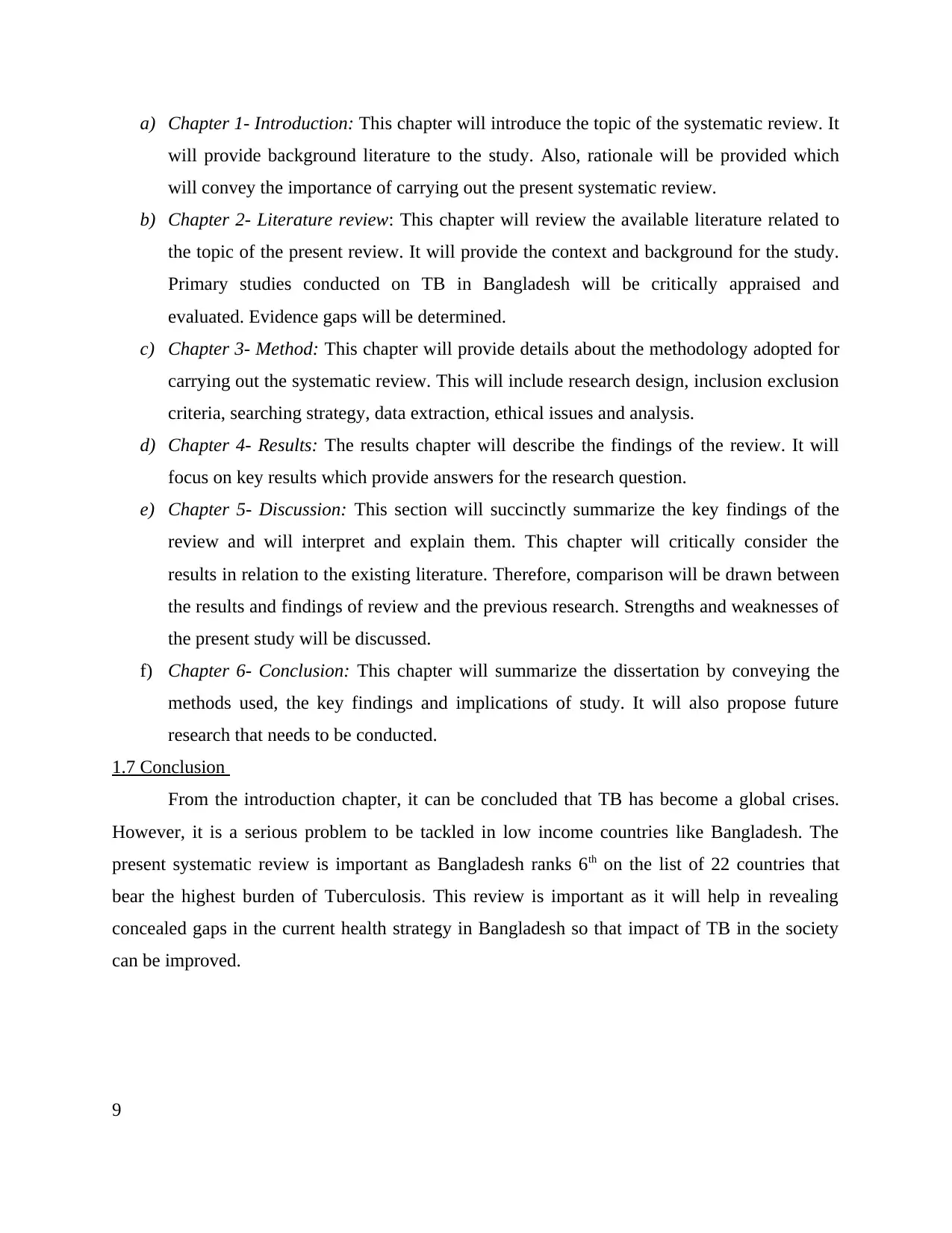
a) Chapter 1- Introduction: This chapter will introduce the topic of the systematic review. It
will provide background literature to the study. Also, rationale will be provided which
will convey the importance of carrying out the present systematic review.
b) Chapter 2- Literature review: This chapter will review the available literature related to
the topic of the present review. It will provide the context and background for the study.
Primary studies conducted on TB in Bangladesh will be critically appraised and
evaluated. Evidence gaps will be determined.
c) Chapter 3- Method: This chapter will provide details about the methodology adopted for
carrying out the systematic review. This will include research design, inclusion exclusion
criteria, searching strategy, data extraction, ethical issues and analysis.
d) Chapter 4- Results: The results chapter will describe the findings of the review. It will
focus on key results which provide answers for the research question.
e) Chapter 5- Discussion: This section will succinctly summarize the key findings of the
review and will interpret and explain them. This chapter will critically consider the
results in relation to the existing literature. Therefore, comparison will be drawn between
the results and findings of review and the previous research. Strengths and weaknesses of
the present study will be discussed.
f) Chapter 6- Conclusion: This chapter will summarize the dissertation by conveying the
methods used, the key findings and implications of study. It will also propose future
research that needs to be conducted.
1.7 Conclusion
From the introduction chapter, it can be concluded that TB has become a global crises.
However, it is a serious problem to be tackled in low income countries like Bangladesh. The
present systematic review is important as Bangladesh ranks 6th on the list of 22 countries that
bear the highest burden of Tuberculosis. This review is important as it will help in revealing
concealed gaps in the current health strategy in Bangladesh so that impact of TB in the society
can be improved.
9
will provide background literature to the study. Also, rationale will be provided which
will convey the importance of carrying out the present systematic review.
b) Chapter 2- Literature review: This chapter will review the available literature related to
the topic of the present review. It will provide the context and background for the study.
Primary studies conducted on TB in Bangladesh will be critically appraised and
evaluated. Evidence gaps will be determined.
c) Chapter 3- Method: This chapter will provide details about the methodology adopted for
carrying out the systematic review. This will include research design, inclusion exclusion
criteria, searching strategy, data extraction, ethical issues and analysis.
d) Chapter 4- Results: The results chapter will describe the findings of the review. It will
focus on key results which provide answers for the research question.
e) Chapter 5- Discussion: This section will succinctly summarize the key findings of the
review and will interpret and explain them. This chapter will critically consider the
results in relation to the existing literature. Therefore, comparison will be drawn between
the results and findings of review and the previous research. Strengths and weaknesses of
the present study will be discussed.
f) Chapter 6- Conclusion: This chapter will summarize the dissertation by conveying the
methods used, the key findings and implications of study. It will also propose future
research that needs to be conducted.
1.7 Conclusion
From the introduction chapter, it can be concluded that TB has become a global crises.
However, it is a serious problem to be tackled in low income countries like Bangladesh. The
present systematic review is important as Bangladesh ranks 6th on the list of 22 countries that
bear the highest burden of Tuberculosis. This review is important as it will help in revealing
concealed gaps in the current health strategy in Bangladesh so that impact of TB in the society
can be improved.
9
⊘ This is a preview!⊘
Do you want full access?
Subscribe today to unlock all pages.

Trusted by 1+ million students worldwide
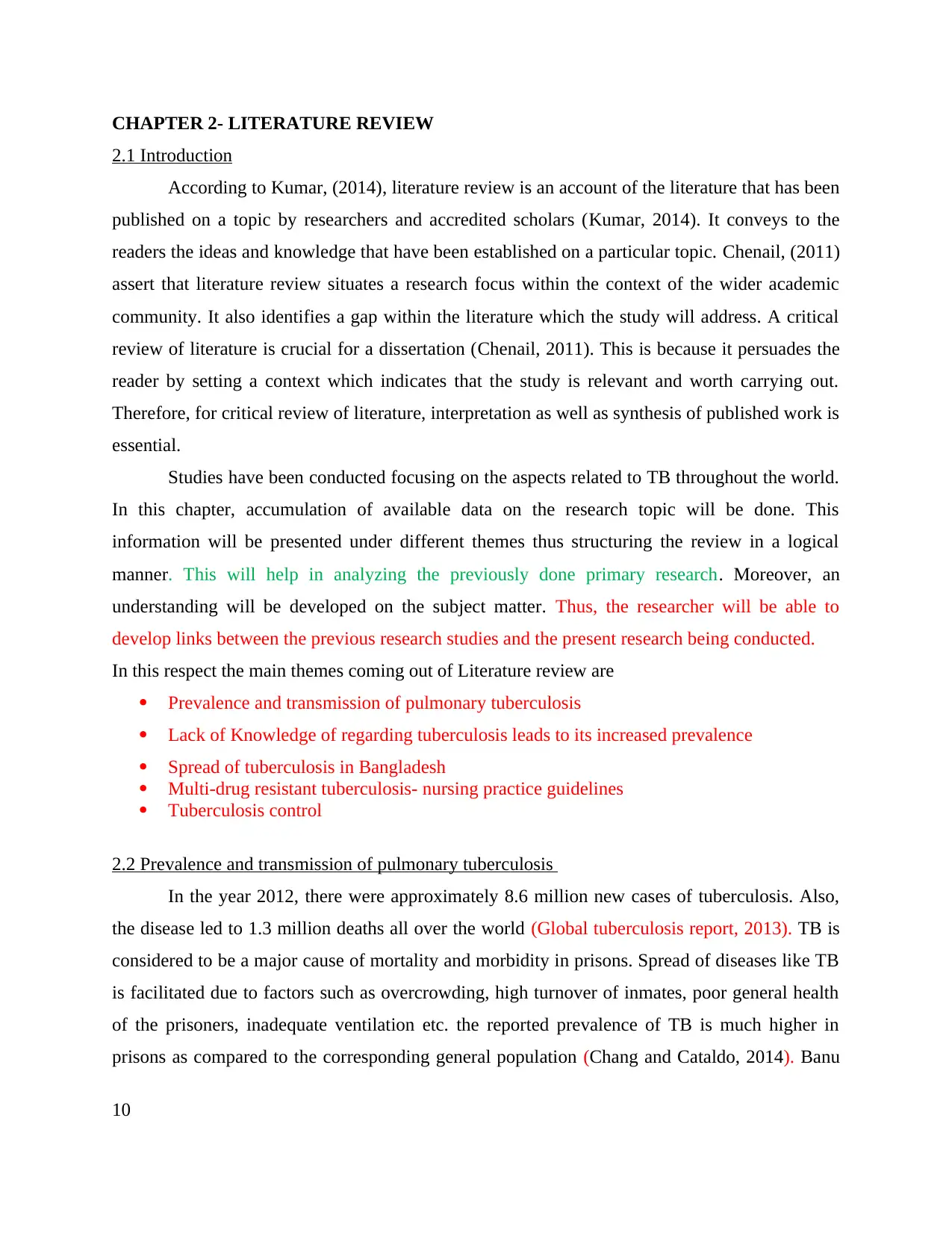
CHAPTER 2- LITERATURE REVIEW
2.1 Introduction
According to Kumar, (2014), literature review is an account of the literature that has been
published on a topic by researchers and accredited scholars (Kumar, 2014). It conveys to the
readers the ideas and knowledge that have been established on a particular topic. Chenail, (2011)
assert that literature review situates a research focus within the context of the wider academic
community. It also identifies a gap within the literature which the study will address. A critical
review of literature is crucial for a dissertation (Chenail, 2011). This is because it persuades the
reader by setting a context which indicates that the study is relevant and worth carrying out.
Therefore, for critical review of literature, interpretation as well as synthesis of published work is
essential.
Studies have been conducted focusing on the aspects related to TB throughout the world.
In this chapter, accumulation of available data on the research topic will be done. This
information will be presented under different themes thus structuring the review in a logical
manner. This will help in analyzing the previously done primary research. Moreover, an
understanding will be developed on the subject matter. Thus, the researcher will be able to
develop links between the previous research studies and the present research being conducted.
In this respect the main themes coming out of Literature review are
Prevalence and transmission of pulmonary tuberculosis
Lack of Knowledge of regarding tuberculosis leads to its increased prevalence
Spread of tuberculosis in Bangladesh
Multi-drug resistant tuberculosis- nursing practice guidelines
Tuberculosis control
2.2 Prevalence and transmission of pulmonary tuberculosis
In the year 2012, there were approximately 8.6 million new cases of tuberculosis. Also,
the disease led to 1.3 million deaths all over the world (Global tuberculosis report, 2013). TB is
considered to be a major cause of mortality and morbidity in prisons. Spread of diseases like TB
is facilitated due to factors such as overcrowding, high turnover of inmates, poor general health
of the prisoners, inadequate ventilation etc. the reported prevalence of TB is much higher in
prisons as compared to the corresponding general population (Chang and Cataldo, 2014). Banu
10
2.1 Introduction
According to Kumar, (2014), literature review is an account of the literature that has been
published on a topic by researchers and accredited scholars (Kumar, 2014). It conveys to the
readers the ideas and knowledge that have been established on a particular topic. Chenail, (2011)
assert that literature review situates a research focus within the context of the wider academic
community. It also identifies a gap within the literature which the study will address. A critical
review of literature is crucial for a dissertation (Chenail, 2011). This is because it persuades the
reader by setting a context which indicates that the study is relevant and worth carrying out.
Therefore, for critical review of literature, interpretation as well as synthesis of published work is
essential.
Studies have been conducted focusing on the aspects related to TB throughout the world.
In this chapter, accumulation of available data on the research topic will be done. This
information will be presented under different themes thus structuring the review in a logical
manner. This will help in analyzing the previously done primary research. Moreover, an
understanding will be developed on the subject matter. Thus, the researcher will be able to
develop links between the previous research studies and the present research being conducted.
In this respect the main themes coming out of Literature review are
Prevalence and transmission of pulmonary tuberculosis
Lack of Knowledge of regarding tuberculosis leads to its increased prevalence
Spread of tuberculosis in Bangladesh
Multi-drug resistant tuberculosis- nursing practice guidelines
Tuberculosis control
2.2 Prevalence and transmission of pulmonary tuberculosis
In the year 2012, there were approximately 8.6 million new cases of tuberculosis. Also,
the disease led to 1.3 million deaths all over the world (Global tuberculosis report, 2013). TB is
considered to be a major cause of mortality and morbidity in prisons. Spread of diseases like TB
is facilitated due to factors such as overcrowding, high turnover of inmates, poor general health
of the prisoners, inadequate ventilation etc. the reported prevalence of TB is much higher in
prisons as compared to the corresponding general population (Chang and Cataldo, 2014). Banu
10
Paraphrase This Document
Need a fresh take? Get an instant paraphrase of this document with our AI Paraphraser
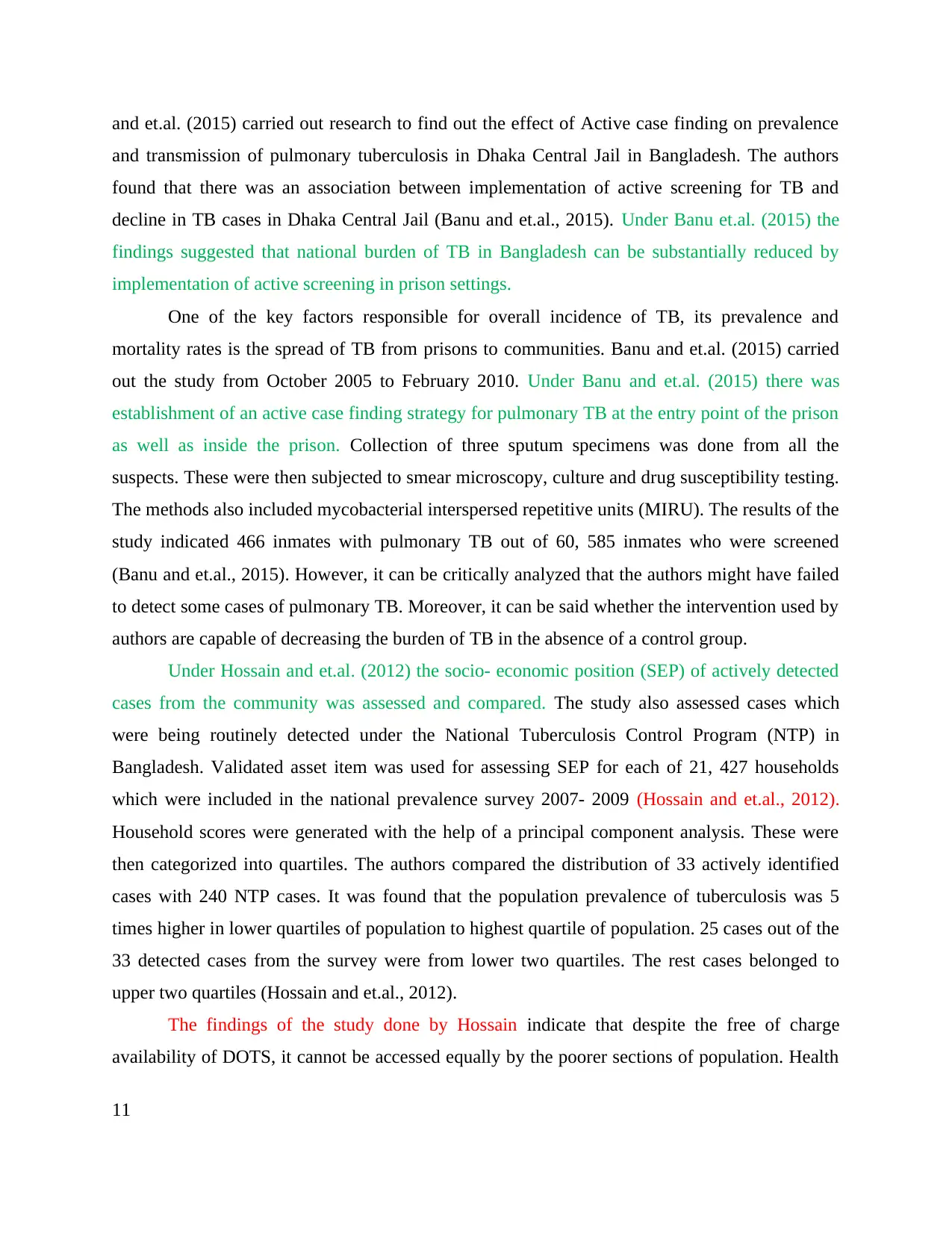
and et.al. (2015) carried out research to find out the effect of Active case finding on prevalence
and transmission of pulmonary tuberculosis in Dhaka Central Jail in Bangladesh. The authors
found that there was an association between implementation of active screening for TB and
decline in TB cases in Dhaka Central Jail (Banu and et.al., 2015). Under Banu et.al. (2015) the
findings suggested that national burden of TB in Bangladesh can be substantially reduced by
implementation of active screening in prison settings.
One of the key factors responsible for overall incidence of TB, its prevalence and
mortality rates is the spread of TB from prisons to communities. Banu and et.al. (2015) carried
out the study from October 2005 to February 2010. Under Banu and et.al. (2015) there was
establishment of an active case finding strategy for pulmonary TB at the entry point of the prison
as well as inside the prison. Collection of three sputum specimens was done from all the
suspects. These were then subjected to smear microscopy, culture and drug susceptibility testing.
The methods also included mycobacterial interspersed repetitive units (MIRU). The results of the
study indicated 466 inmates with pulmonary TB out of 60, 585 inmates who were screened
(Banu and et.al., 2015). However, it can be critically analyzed that the authors might have failed
to detect some cases of pulmonary TB. Moreover, it can be said whether the intervention used by
authors are capable of decreasing the burden of TB in the absence of a control group.
Under Hossain and et.al. (2012) the socio- economic position (SEP) of actively detected
cases from the community was assessed and compared. The study also assessed cases which
were being routinely detected under the National Tuberculosis Control Program (NTP) in
Bangladesh. Validated asset item was used for assessing SEP for each of 21, 427 households
which were included in the national prevalence survey 2007- 2009 (Hossain and et.al., 2012).
Household scores were generated with the help of a principal component analysis. These were
then categorized into quartiles. The authors compared the distribution of 33 actively identified
cases with 240 NTP cases. It was found that the population prevalence of tuberculosis was 5
times higher in lower quartiles of population to highest quartile of population. 25 cases out of the
33 detected cases from the survey were from lower two quartiles. The rest cases belonged to
upper two quartiles (Hossain and et.al., 2012).
The findings of the study done by Hossain indicate that despite the free of charge
availability of DOTS, it cannot be accessed equally by the poorer sections of population. Health
11
and transmission of pulmonary tuberculosis in Dhaka Central Jail in Bangladesh. The authors
found that there was an association between implementation of active screening for TB and
decline in TB cases in Dhaka Central Jail (Banu and et.al., 2015). Under Banu et.al. (2015) the
findings suggested that national burden of TB in Bangladesh can be substantially reduced by
implementation of active screening in prison settings.
One of the key factors responsible for overall incidence of TB, its prevalence and
mortality rates is the spread of TB from prisons to communities. Banu and et.al. (2015) carried
out the study from October 2005 to February 2010. Under Banu and et.al. (2015) there was
establishment of an active case finding strategy for pulmonary TB at the entry point of the prison
as well as inside the prison. Collection of three sputum specimens was done from all the
suspects. These were then subjected to smear microscopy, culture and drug susceptibility testing.
The methods also included mycobacterial interspersed repetitive units (MIRU). The results of the
study indicated 466 inmates with pulmonary TB out of 60, 585 inmates who were screened
(Banu and et.al., 2015). However, it can be critically analyzed that the authors might have failed
to detect some cases of pulmonary TB. Moreover, it can be said whether the intervention used by
authors are capable of decreasing the burden of TB in the absence of a control group.
Under Hossain and et.al. (2012) the socio- economic position (SEP) of actively detected
cases from the community was assessed and compared. The study also assessed cases which
were being routinely detected under the National Tuberculosis Control Program (NTP) in
Bangladesh. Validated asset item was used for assessing SEP for each of 21, 427 households
which were included in the national prevalence survey 2007- 2009 (Hossain and et.al., 2012).
Household scores were generated with the help of a principal component analysis. These were
then categorized into quartiles. The authors compared the distribution of 33 actively identified
cases with 240 NTP cases. It was found that the population prevalence of tuberculosis was 5
times higher in lower quartiles of population to highest quartile of population. 25 cases out of the
33 detected cases from the survey were from lower two quartiles. The rest cases belonged to
upper two quartiles (Hossain and et.al., 2012).
The findings of the study done by Hossain indicate that despite the free of charge
availability of DOTS, it cannot be accessed equally by the poorer sections of population. Health
11
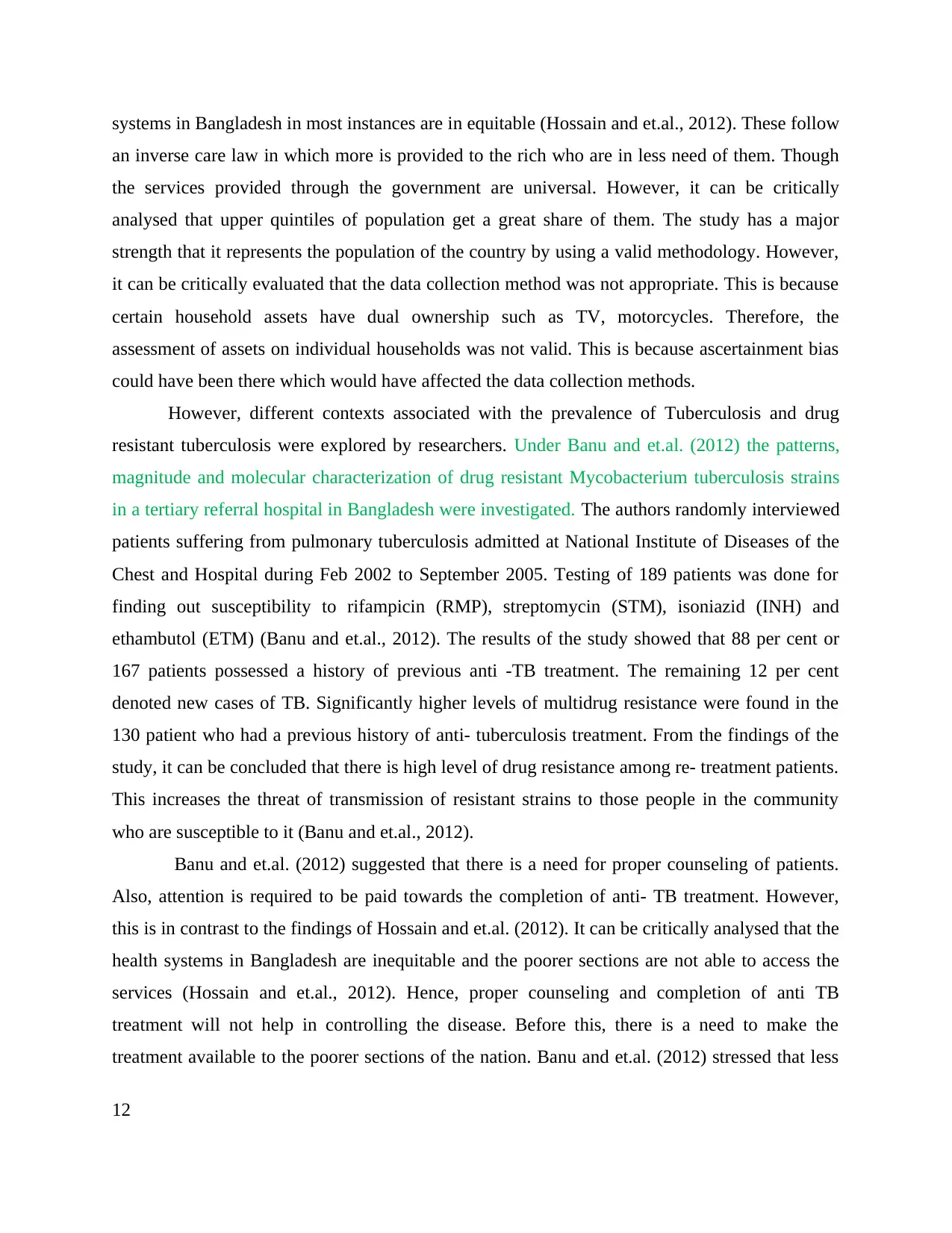
systems in Bangladesh in most instances are in equitable (Hossain and et.al., 2012). These follow
an inverse care law in which more is provided to the rich who are in less need of them. Though
the services provided through the government are universal. However, it can be critically
analysed that upper quintiles of population get a great share of them. The study has a major
strength that it represents the population of the country by using a valid methodology. However,
it can be critically evaluated that the data collection method was not appropriate. This is because
certain household assets have dual ownership such as TV, motorcycles. Therefore, the
assessment of assets on individual households was not valid. This is because ascertainment bias
could have been there which would have affected the data collection methods.
However, different contexts associated with the prevalence of Tuberculosis and drug
resistant tuberculosis were explored by researchers. Under Banu and et.al. (2012) the patterns,
magnitude and molecular characterization of drug resistant Mycobacterium tuberculosis strains
in a tertiary referral hospital in Bangladesh were investigated. The authors randomly interviewed
patients suffering from pulmonary tuberculosis admitted at National Institute of Diseases of the
Chest and Hospital during Feb 2002 to September 2005. Testing of 189 patients was done for
finding out susceptibility to rifampicin (RMP), streptomycin (STM), isoniazid (INH) and
ethambutol (ETM) (Banu and et.al., 2012). The results of the study showed that 88 per cent or
167 patients possessed a history of previous anti -TB treatment. The remaining 12 per cent
denoted new cases of TB. Significantly higher levels of multidrug resistance were found in the
130 patient who had a previous history of anti- tuberculosis treatment. From the findings of the
study, it can be concluded that there is high level of drug resistance among re- treatment patients.
This increases the threat of transmission of resistant strains to those people in the community
who are susceptible to it (Banu and et.al., 2012).
Banu and et.al. (2012) suggested that there is a need for proper counseling of patients.
Also, attention is required to be paid towards the completion of anti- TB treatment. However,
this is in contrast to the findings of Hossain and et.al. (2012). It can be critically analysed that the
health systems in Bangladesh are inequitable and the poorer sections are not able to access the
services (Hossain and et.al., 2012). Hence, proper counseling and completion of anti TB
treatment will not help in controlling the disease. Before this, there is a need to make the
treatment available to the poorer sections of the nation. Banu and et.al. (2012) stressed that less
12
an inverse care law in which more is provided to the rich who are in less need of them. Though
the services provided through the government are universal. However, it can be critically
analysed that upper quintiles of population get a great share of them. The study has a major
strength that it represents the population of the country by using a valid methodology. However,
it can be critically evaluated that the data collection method was not appropriate. This is because
certain household assets have dual ownership such as TV, motorcycles. Therefore, the
assessment of assets on individual households was not valid. This is because ascertainment bias
could have been there which would have affected the data collection methods.
However, different contexts associated with the prevalence of Tuberculosis and drug
resistant tuberculosis were explored by researchers. Under Banu and et.al. (2012) the patterns,
magnitude and molecular characterization of drug resistant Mycobacterium tuberculosis strains
in a tertiary referral hospital in Bangladesh were investigated. The authors randomly interviewed
patients suffering from pulmonary tuberculosis admitted at National Institute of Diseases of the
Chest and Hospital during Feb 2002 to September 2005. Testing of 189 patients was done for
finding out susceptibility to rifampicin (RMP), streptomycin (STM), isoniazid (INH) and
ethambutol (ETM) (Banu and et.al., 2012). The results of the study showed that 88 per cent or
167 patients possessed a history of previous anti -TB treatment. The remaining 12 per cent
denoted new cases of TB. Significantly higher levels of multidrug resistance were found in the
130 patient who had a previous history of anti- tuberculosis treatment. From the findings of the
study, it can be concluded that there is high level of drug resistance among re- treatment patients.
This increases the threat of transmission of resistant strains to those people in the community
who are susceptible to it (Banu and et.al., 2012).
Banu and et.al. (2012) suggested that there is a need for proper counseling of patients.
Also, attention is required to be paid towards the completion of anti- TB treatment. However,
this is in contrast to the findings of Hossain and et.al. (2012). It can be critically analysed that the
health systems in Bangladesh are inequitable and the poorer sections are not able to access the
services (Hossain and et.al., 2012). Hence, proper counseling and completion of anti TB
treatment will not help in controlling the disease. Before this, there is a need to make the
treatment available to the poorer sections of the nation. Banu and et.al. (2012) stressed that less
12
⊘ This is a preview!⊘
Do you want full access?
Subscribe today to unlock all pages.

Trusted by 1+ million students worldwide
1 out of 67
Related Documents
Your All-in-One AI-Powered Toolkit for Academic Success.
+13062052269
info@desklib.com
Available 24*7 on WhatsApp / Email
![[object Object]](/_next/static/media/star-bottom.7253800d.svg)
Unlock your academic potential
Copyright © 2020–2025 A2Z Services. All Rights Reserved. Developed and managed by ZUCOL.





